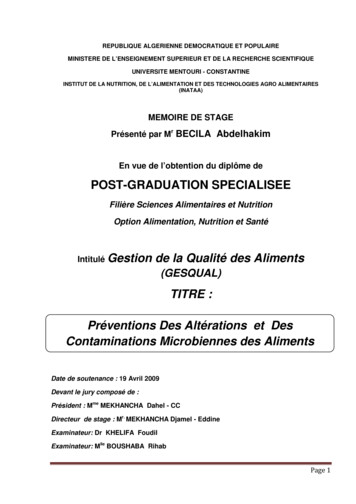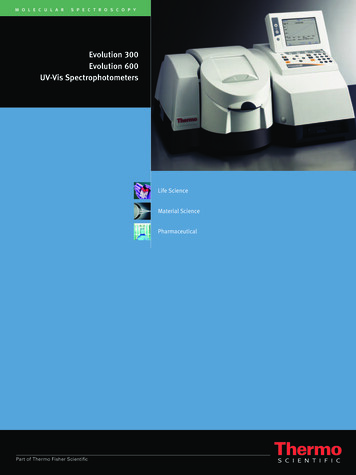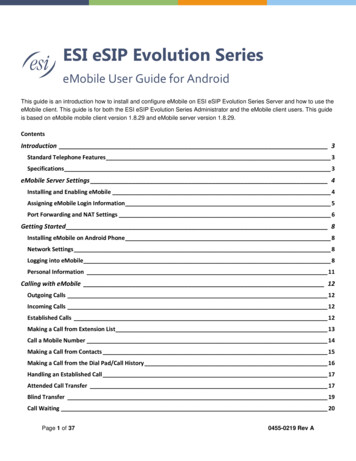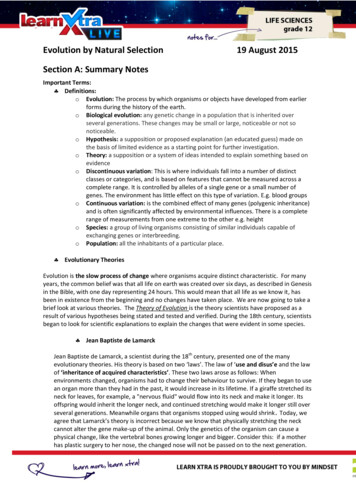
Transcription
The Evolution ofCo-Management
Copyright 2017 by Society of Hospital Medicine.All rights reserved.No part of this publication may be reproduced,stored in retrieval system, or transmitted, in anyform or by any means, electronic, mechanical,photocopying, recording, or otherwise, without priorwritten consent. Unlawful scanning, uploading anddistribution of this book via the Internet or via anyother means without the permission of the Societyof Hospital Medicine may be punishable by law.For more information or to obtain additional copiescontact SHM at: Phone: 800-843-3360.
ContentsCo-Management Workgroup2016–2017 Roster 1Chair 1Members 1Staff 1Introduction and Background 2Pearls of wisdom 3Co-management models 3Collaborative practice agreements 4Things to look out for 4Metrics for successful co‑management program 7Innovations in co‑management 7References 8
Co-ManagementWorkgroup2016–2017 RosterThe charge of the Co-Management Work Group of thePractice Management Committee is to define the rolesof hospitalists within co-management systems whilearticulating what a successful co-management systemlooks like.ChairHardik Vora, MD, MPHRiverside Medical GroupMembersBill Atchley, MDSentara Medical GroupStephen Behnke, MDMed OneChris Cockerham, MDMarietta Memorial Health SystemO’Neil Pyke, MDMedicus Healthcare SolutionsRoy Sittig, MDSound PhysiciansStaffPatrick Vulgamore, MPHSociety of Hospital Medicine1The Evolution of Co-Management
O ver the past two decades,hospital medicine as aspecialty has grown andevolved rapidly, resultingin various hospitalmedicine models.Introduction and BackgroundPer data extrapolated from the 2015 American HospitalAssociation survey, 92% of hospitals with more than 200beds utilized hospitalists (penetration has steadily risensince 2003, when it stood at 46%). One of the myriadreasons that hospital medicine has grown so quickly inboth the number and compensation of providers (10.2%increase in compensation from 2014 to 2016) is due tothe value that hospitalists bring in the co-managementof patients. The Society of Hospital Medicine (SHM)recognized this synergy and, in 2006, produced bestpractices, toolkits, sample agreements and casestudies on hospitalists’ roles in co‑management.Given the evolution of hospitalists’ scope of servicesand the ever-growing specialization of hospitalists,SHM’s Board requested that the Practice ManagementCommittee form a workgroup to provide an update onco-management in hospital medicine. The followingdocument should be used as a guide while establishingthe co‑management agreement between the hospitalistteam and the non-hospitalist specialty team to provideclarity and set expectations for the entire care team.92% of hospitalswith more than 200 bedsutilized hospitalistsOver the past two decades, hospital medicine as aspecialty has grown and evolved rapidly, resultingin various hospital medicine models. As predicted,1Hospital Medicine Groups (HMGs) were found to bringsignificant value in the care of hospitalized patients,while simultaneously improving the efficiency ofhealth systems and hospitals. Hospitalists were utilizedto streamline the flow of patient care and provideimproved clinical access for patients in the hospital.One way that hospitalists have increasingly beenutilized, particularly over the last decade, is in a comanagement role alongside subspecialty partners inways that are considered non‑traditional to primary caretrained physicians, such as in neurosurgical, orthopedic,oncologic or other subspecialty patient groups.2Co-management models have shown significantpositive effects on patient care with decreases inhospital mortality rates, improved patient safety andimproved pain scores.3 Not only has it been provento be preferential among clinicians,4 co-managementhas been associated with significant cost savings perhospitalization.5 Most recently, Rohatgi, et al. (2016)found that intervention by surgical co-managinghospitalists was associated with a significant decreasein medical complications, length of stay (LOS), 30-dayreadmission rates, number of medical consultants andcost of care, and a nonsignificant increase in patientsatisfaction.6Often, co-management arrangements are coordinatedas a solution for subspecialist staffing or coverageissues, medical complexity in surgical patients orfor the efficiency of the emergency department.An unintended consequence of co-managementarrangements can be inconsistent interpretation ofthe roles and responsibilities to the patient betweenthe hospital medicine inpatient generalist and thesubspecialists.7The Evolution of Co-Management2
Pearls of wisdom Programs that have bi-directional agreements in placeare more successful. Hospitalists and subspecialists should have equalstake/say in the structure of the agreement. There should be solid conflict resolution plans.Conflicts are broadly divided in two major categories:operational and clinical. Operational conflicts should be escalated tothe leadership of both groups for resolution. Ifno resolution is reached, the conflict should beescalated to hospital administration, medical staffleadership or medical group leadership, dependingon the governing structure of the groups. Clinical conflicts are typically handled by theattending physician. If one remains concerned aboutclinical practice, the conflict should be escalated toleaderships of each group, and possibly the qualityreview committee at the hospital. All providers must function within a well-definedand appropriate scope of practice based on theirtraining and experience — e.g., hospitalists shouldnot be expected to or be responsible for determiningtiming of procedure (surgery or intervention) and/orpostprocedural care and monitoring, even if they arethe attending of record. Similarly, specialists should not be expected toor be responsible for managing chronic medicalissues or identifying and managing acute medicalissues, even if they are the attending on record. Incorporate systematic review of co-managementagreements in the workflow to examine the outcomes(positives and negatives) of co-management andadjust as and when necessary.3The Evolution of Co-ManagementCo-managementmodelsThere are two primary models that incorporatehospitalists as co-managers. The first model assigns thehospitalist as the patient’s primary attending, utilizing thesubspecialist as a consultant. The second model assignsthe hospitalist to serve as a consultant to the patientwhile the subspecialist is the patient’s primary attending.Either model can work effectively in the rightcircumstances, with agreement and support from thecollaborating parties. However, if the co-managementstructure is not clearly defined, inconsistentexpectations or frequent misinterpretation of rolesmay develop for key hospital stakeholders, such as thenursing staff, other medical staff members and oftenfor the co-managers themselves. The factors involvedwith the roles in the co-management program will varydepending upon the type of model chosen.
CollaborativepracticeagreementsRegardless of the model chosen, co-managementprograms need to provide clear guidance for all partiesthrough a comprehensive written policy known as aCo-Management Agreement or Service Line Agreement(also known as a Memorandum of Understanding [MOU]in some institutions). Such an agreement should bedesigned with all engaged parties that outlines the rolesand responsibilities of each provider type involved inpatient care. Particularly, an agreement should ensurecontinued provider engagement throughout the patientcare episode, with focus around handoffs and sign-offsduring the episode.A well-crafted agreement should also identify criticalcommunication processes and clinical expectations toavoid compromising patient safety and putting patientsand providers at risk. If the co-managers cannot come toagreement of an appropriate level of engagement, thena co-management program should NOT be developedfor the service lines.Due to the unique characteristics and locations ofour healthcare systems around the country, a onesize-fits-all approach to co-management does notexist. Roles/responsibilities and scope of practice ofhospitalists in a co-management model must consider“local factors” to develop an effective and sustainableco-management program. Even the best-definedagreements and programs cannot foresee or accountfor all contingencies. All parties should recognizethat changes may need to occur in the agreementover time based on the co-management experiencesand patient and staff satisfaction/clinical outcomes.Best practice would suggest having co-managementset up as collegial arrangements with open lines ofcommunication. A conflict resolution pathway, as statedabove, will help to mitigate patient safety concerns inthe involved service lines as unintended or unforeseenconflicts often arise.Things to lookout forThe most significant concern for co-managementprograms is ensuring that all parties involved arefunctioning within the scope of their clinical trainingand expertise. A high-quality co-managementmodel will develop and incorporate appropriateclinical boundaries and clear pathways for providercoordination and communication. Scope creep canoccur, for example, when a hospitalist is designatedas the attending physician of a patient with a primaryclinical issue that falls outside of the scope of traditionalhospitalist training. Without adequate engagement ofthe consultant, there is increased risk and frustrationfor the hospitalist and likely poorer clinical outcomesfor the patient.A challenge in this situation could arise if staff and/orpatients direct inquiries toward the hospitalist thatare best answered by the subspecialist involved inthe patient’s care. This type of situation may place thehospitalist in an awkward position of having to makedecisions about a medication or treatment plan withwhich they’ve had limited exposure or experience.Consequences then may result in provider (bothhospitalist and subspecialist) dissatisfaction andburnout, increased redundancy of care and inefficientresource utilization, along with increased medicallegal risk. Skill sets and subspecialty expertise ofhospitalists vary widely depending on experience, anda well-defined agreement ensures appropriate clinicalexpectations for all roles.There is, however, a rationale for having hospitalistsserve as the primary attending on surgical orother subspecialty hospitalized patients where thehospitalist does not have detailed training on that typeof subspecialty patient. This is related to hospitalistexpertise in standardization of processes withinthe workflow of the hospital. Hospitalists bring thefollowing strengths to this type of agreement: emergency room (ER) flow electronic medical record (EMR) and order set usage clinical processes social work/case management connection patient/family discussionsThe Evolution of Co-Management4
A s some surgeons or medicalsubspecialists may have less timeto dedicate to the minute-to-minuteinpatient care, while spendingdaytime hours in the operatingroom (OR) or outpatient clinic,hospitalists may have more time todedicate to hospital processes, helpinggenerate standardized managementstreams that could improve patientsatisfaction, hospital care transitionsand overall hospital flow.5The Evolution of Co-Management
Things to look out for (continued)When designing a co-management program or agreement,here are some considerations: The current culture of your organization is animportant contributor. If you have traditionallycared for a group of patients, should you continueto provide that care or did it spring from a previousneed and is no longer in the patient’s best interest?For example, if the staffing for subspecialists waslimited and the hospitalists agreed to admit theirpatients, and now they become fully staffed, shouldthe arrangement continue? In certain practice settings (e.g., rural, suburban vs.urban, academic vs. community hospitals) with limitedavailable resources (e.g., size of specialty group mayinfluence structure of co-management program), theHMG might be tasked with more responsibilities. Anexample of this occurs when specialist group size istoo small to provide sustainable 24x7 coverage. Training, knowledge base and experience ofhospitalists: Do your hospitalists have the training,knowledge base and skills to take on additionalresponsibilities that come with being the attendingphysician in a co-management agreement?Do you have resources available for ongoing skilldevelopment for your providers? Provider engagement is the single most importantfactor influencing success of co-managementprograms. Co-management programs are unlikelyto succeed if providers are not truly engaged. Riskof provider disengagement is higher when theco‑management program is an arrangement ofconvenience for specialists and not driven by goalsof adding value and improving the quality andefficiency of patient care. Impact of staffing and provider satisfaction:Do you have adequate staffing for additional patientvolume? Unstructured growth of a HMG’s patientvolume through co-management agreements canlead to significant staffing shortages and instabilitywithin the HMG. Role of nurse practitioners (NPs) and physicianassistants (PAs): Consider optimizing NP andPA expertise while developing co-managementprograms. NPs and PAs can play a vital role inbuilding sustainable co-management programswhen appropriately trained and deployed. Financial impact of co-management program:Co‑management can have both positive andsometimes negative impacts on the hospital, thehospitalists and the subspecialists, especiallyif not carefully designed. A carefully designedco‑management program can have a positive financialimpact by improving documentation, and LOS (e.g.,optimal management of chronic comorbidities andearly recognition/management of acute medicalissues, improving medication management). As we move to a value-based healthcare deliverysystem, it is critical that we carefully examine andremove redundancy in healthcare. Do you havetwo providers managing the same problem?Would your co-management program be viable astransition away from a fee-for-service approach? Medical-legal risk of both co-management models. Considerations for different models: If using the hospitalist as consultant, at what pointshould the hospitalists sign off; what is the role ofthe hospitalist in managing coordination of care? If using the hospitalist as primary, how doesthe program ensure engagement by thesubspecialists throughout the patient stay?How does the program ensure that hospitalists’responsibilities are within their scope of practiceand clinical training?It is important to consider and develop aco‑management program that works for your practicesetting. Regardless of the hospitalists’ role (e.g.,consultant vs. attending) in the co-managementprogram, they must function within a well-defined andappropriate scope of practice, based on their trainingand experience. It is critically important to set clearexpectations and define roles and responsibilities ofeach provider that are within their scope of practice andconsistent with their training and expertise.No matter how your co-management practice is setup, it is important that you always ensure that patientsafety is at the cornerstone of the agreement. Whileprovider convenience may be a central motivator, it isparamount that the patient be placed at the center of allnegotiations. A successful co-management agreementallows providers to deliver high-quality, cost-efficientcare for our patients.The Evolution of Co-Management6
Metrics forsuccessfulco‑managementprogramHere are some suggested metrics to determine thevalue of a co-management program. The successof co‑management programs can be defined andmeasured in various ways, with the following threebroad categories serving as a foundation. Quality metrics are key to proving how hospitalistsare adding value to patient care, and co-managementagreements make it clear on how to most effectivelydisperse expertise. A few examples include: Medication reconciliation accuracy Readmissions Hospital-Acquired Infection (HAI) reduction Order set compliance Timing to surgical intervention Engagement metrics will help articulate theeffectiveness of co-management agreements, asimprecision or lack of co-management agreementscan cause misinterpretation of roles anddissatisfaction, leading to burnout. Considerthe following measures when examining theeffect of a co-management agreement: Provider satisfaction Ancillary services satisfaction Recruitment and retention(for both specialists and hospitalists) Patient satisfaction Financial components are important to trackfor the purpose of program sustainability, especiallyconsidering the shift to value and stewardshipof limited resources. Here are a few examples ofdata points: Clinical documentation accuracy Length of stay Resource utilization7The Evolution of Co-ManagementInnovations inco‑managementOver the past 20 years, the concept of co-managementhas evolved and will continue to evolve. In the earlyyears of hospital medicine, hospitalists were primarilythe attending physician for primary care physicians’hospitalized patients. As hospital medicine evolved,hospitalists became involved in co-managementof medical subspecialty patients, then on to theco‑management of surgical patients. What does thefuture hold for other areas of co-management? Already,hospitalists are being asked to co-manage pregnantpatients with medical illness and interventionalradiology patients requiring overnight stay. In someparts of the United States, hospitalists are being askedto co-manage psychiatric patients as well as patientsbeing evaluated for coronary bypass surgery. Thereis a logic behind the present and the future states ofco‑management, as it plays an integral role involvingthe management of acute and chronic medicalissues and facilitating care coordination. The futuredevelopment of co-management will now be drivenby issues that, if dealt with proactively, will only lead tobetter patient care, more efficient healthcare deliveryand subsequent further expansion.Presently, hospitals are facing potential paymentpenalties regarding Hospital Consumer Assessmentof Healthcare Providers and Systems (HCAHPS) andreadmissions. With the growth of alternative paymentmodels (APMs) such as accountable care organizations(ACOs) and bundled payments for care improvement(BPCI), well-functioning co‑management arrangementswill be in even higher demand. The focus on high valuewill be the reality that all physicians will face in the 21stcentury. The success of the co‑management evolutionwill depend on understanding the drivers behindit. Understanding the rationale for the request fromsubspecialists and the hospitals will help to developprograms that meet the needs of the subspecialists,patients, hospitals and hospitalists.
References1. Wachter RM, Goldman L. The emerging role of“hospitalists” in the American health care system.N Engl J Med. 1996;335:514-516.5. Auerbach AD, et al. Comanagement of surgicalpatients between neurosurgeons and hospitalists.Arch Intern Med. 2010 Dec 13;170(22):2004-2010.2. JACC: Heart Failure. J Am Coll Cardiol HF.2013;1:445-453.6. Rohatgi N, Loftus P, Grujic O, Cullen M,Hopkins J, Ahuja N. Surgical comanagement byhospitalists improves patient outcomes. Ann 00016293. Tadros et al. Society of Clinical Vascular Surgery 2015 pgs 1550-1555.4. Huddleston JM, et al. Medical and surgicalcomanagement after elective hip and kneearthroplasty: a randomized, controlled trial. AnnIntern Med. 2004 Jul 6;141(1):28-38.7.Cheng HQ. Comanagement hospitalist servicesfor neurosurgery. Neurosurg Clin N Am. 2015Apr;26(2):295-300.The Evolution of Co-Management8
has been associated with significant cost savings per hospitalization.5 Most recently, Rohatgi, et al. (2016) found that intervention by surgical co-managing hospitalists was associated with a significant decrease in medical complications, length of stay (LOS), 30-day readmission rates, number of medical consultants and











